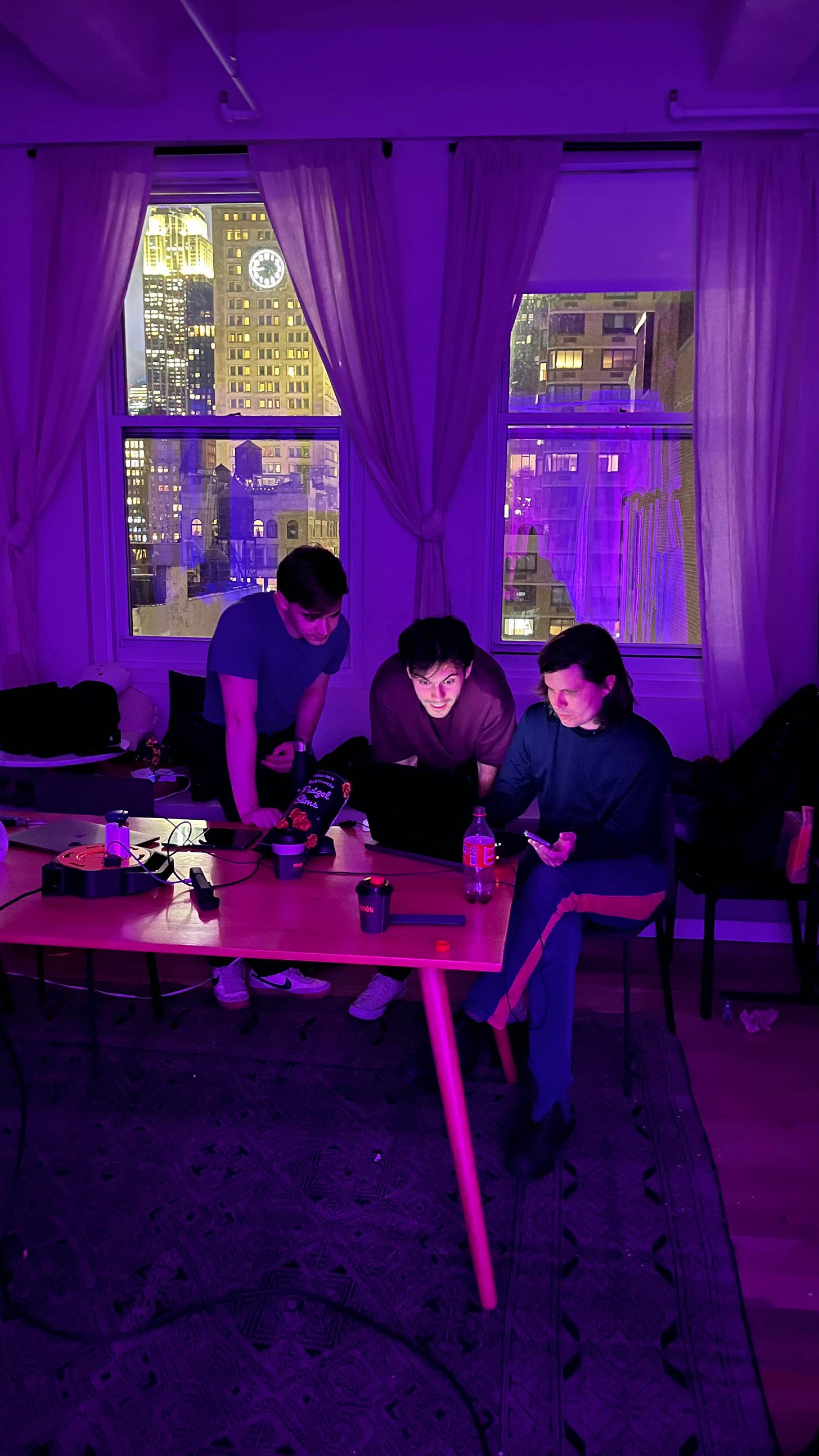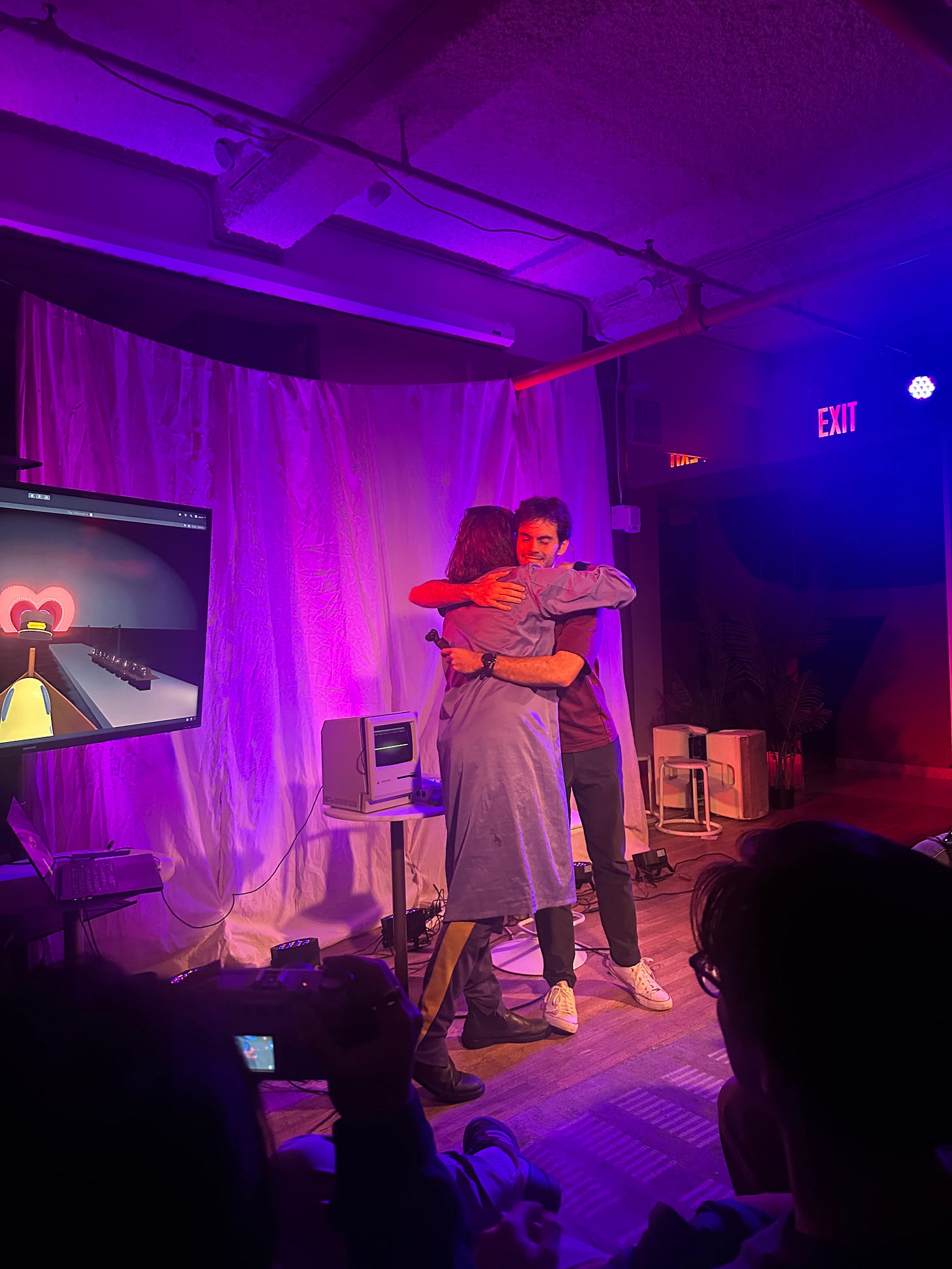It’s not often we choose to leave our comfort zone.
But for the past few months, I’ve been working on something that’s pushed me in ways I didn’t expect — a live show.
You might’ve seen small mentions of it in past updates, tucked at the bottom.
What I haven’t said until now is how challenging the work has been, and how much it’s changed the way I work.
A True Collaborator
The show was co-created with Lucas — a filmmaker, developer, and self-proclaimed mad scientist.
Lucas has created beautiful stories across immersive games, films, and tech experiments.
Coincidentally, he’s also a fellow member of that little creative cult I mentioned last week: Verci.
One day, Lucas casually mentioned he was looking for a full-stack engineer to help build a new genre of live show powered by the audience’s data.
Data visualization in the form of a live show? I bit.
I’ve spent most of the last few years building solo — sometimes with feedback or light help from others, but rarely with a true equal collaborator. And at times, a boss.
Someone who’s just as — or even more — invested in the success of the work than I am.
Lucas was the first collaborator like that in a long time.
He also brought in a few other experts — in lighting, design, and production — recognizing where our own expertise ended and where we needed help to bring the vision fully to life. (shoutout to James, Janice, and Stephen).
We approach things differently — in personality, process, and pace.
But that contrast made the work better. It pushes us both in the best ways.
Building a New Kind of Show
From the jump, Lucas made it clear there was no template to follow.
The only rule was that the show had to run locally — from one computer and the phones of the audience. No wifi. No cell service. No data allowed to leave the room. And has to be able run on any type of (smart)phone the audience might have.
It was an exercise in bending the browser to our will, using local networking and real-time interaction to create something…well we didn't know what it was going to be.
But it wasn’t just about making something work.
Even the technical infrastructure was designed to make the audience feel safe enough to be vulnerable and participate.
After all, Lucas asked that once each show ends, the data disappears with it.
Chaos, Breakage, & Deleted Databases
We broke a lot of shit.
Our first test run collapsed in about 5 seconds and fried our first, tiny router trying to get 30 people to join.
Our second test revealed that the design was wildly unprepared for how human users participate in practice v. in-theory.
And our final test before the show?
Well…Lucas accidentally deleted the entire database minutes before the demo. (In his defense, I didn’t make it very easy to clear our test users.)
But that’s the thing: each time we failed, we sharpened something. The infrastructure and code, yes — but also the trust in each other and the vision.
It wasn’t just technical. It was personal.
Writing A Script
Lucas is an unbelievable storyteller and scriptwriter.
Throughout the build process, the thing I learned most from him was how to tell a story and how important polish is.
But eventually, we had to stop building features and start writing a show.
And that’s where things got tense.
We debated what the content of the show should be, how it should be run, and which moments would define the experience.
Lucas kept pushing the boundaries. He wanted the show to be riskier, more emotionally charged. I wasn’t always sure.
But I had to trust someone else’s gut — and that’s not easy.
To his credit, Lucas took in all my feedback. But he also held firm to his convictions on certain acts.
There are endless ways to tell a story. But Lucas made sure that whatever version we told, it was cohesive, polished, and deeply impactful.
It’s Showtime, Baybeeeee
The show ran this past Friday.
And for the first time, we weren’t just testing — we were actually performing.
In front of 40+ people, the thing we’d built, as strange and delicate as it was, finally came to life.
We saw it, really saw it, in a way we never could in rehearsal. The features we’d obsessed over for months were now being experienced by people who had no idea what went into making them.
Lucas, as the show’s host, nailed every beat while I moved quietly through the crowd, recording moments and silently praying the whole thing wouldn’t collapse.
(I’m happy to report that nothing major did 🫡)
It was as exhilarating as it was terrifying.
But more than that — it was beautiful.
For the first time, we weren’t just staring at our work.
It was staring back at us.
The audience’s response? Emotional. Joyful. Curious. One person said it felt like a show about connection. Another said authenticity. We never told them what it was about — and maybe that’s the point.
They were bursting with ideas for how to build on what we shared. They saw the potential. And more than anything, they agreed: this felt like a totally new form of live show.
If you want to know what actually happens at the show?
Well, you’ll just have to come see it to find out ; )
Reflection
I learned two important things with this demo:
First — share your work. Even if you’re scared. Especially if you’re scared. The things we stare at too long often look worse to us than they really are. This reminder is a recurring theme in this newsletter, but a live show is certainly a different magnitude than an Instagram Reel or tweet (which to my detriment I am also bad at sharing)
Second — iron sharpens iron.
(Or in our case, maybe more like iron sharpens steel — we don’t have the exact same background and expertise, but we still made each other sharper.)
This was a small demo. A little experiment of what’s to come.
But it reminded me just how much more beautiful the work becomes when it’s made with people who care. And how much you can learn when you let yourself be challenged and step out of your comfort zone.
Here’s to more of that.
And thanks Lucas, hope you got some sleep and good food this weekend :D
What I Did This Week — Read Above
You know the drill. Usually this is where I share my work from this past week.
But if you made it this far, you already know what I did this week from the above.
Still, I’m keeping the section for consistency and maybe just for that one reader out there who loves this structure as much as I do.
Consider this part...for an audience of one.
Something Beautiful — Umbral
Umbral by Ezequiel Pini is a beautiful example of creating art with sensors, creating a beautiful installation that mimics water flowing in a river.
It’s made using glass and several LED screens beneath it to create the effect of the digital world reacting to the exact proportions of the rock.
An elegant piece, and definitely inspires me to try out some new stuff with The Device and sensors I have.






Well, your show went better than mine!
congrats on the show!!!